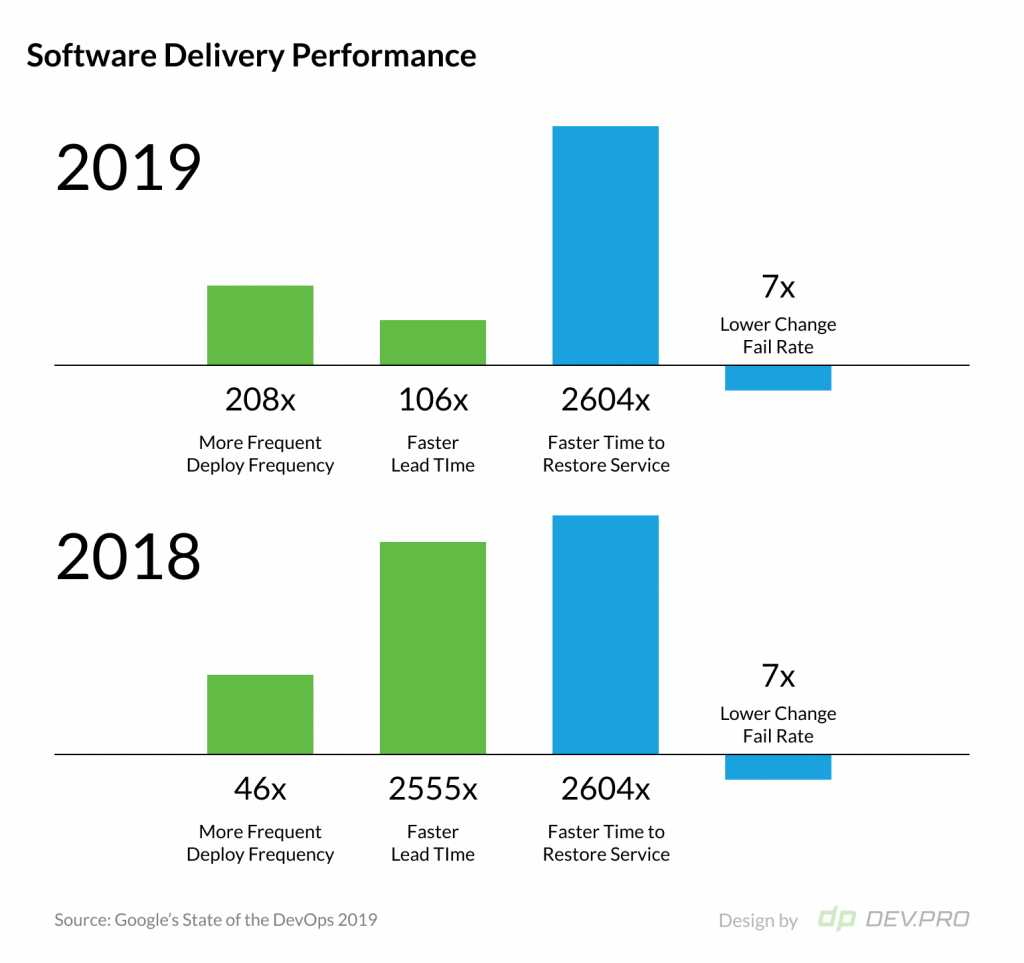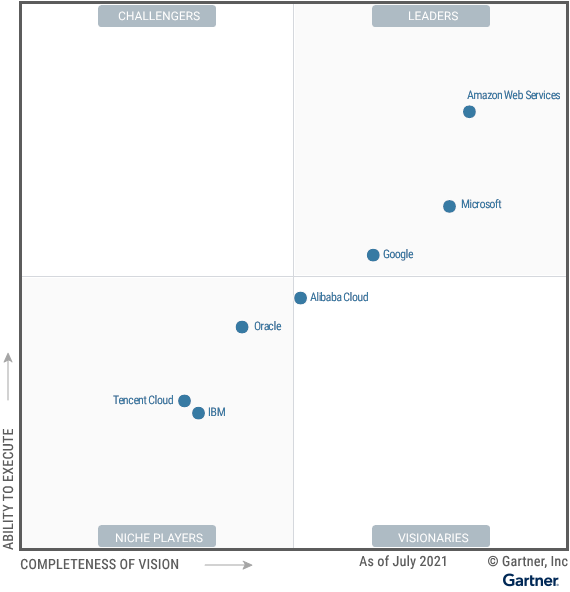Continuous deployment [CD], alongside continuous integration [CI] and delivery, is an essential tool for maintaining sophisticated software products with minimal downtime and seamless customer experience.
According to Google’s State of DevOps 2019 survey, organizations whose performance is qualified as “elite” also happen to deploy 208x more frequently, enjoy 106x faster lead time and spend 2,604x less time to restore features after incidents.
If you, too, aim to join the elite echelon, this article will help you move in the right direction. Let’s start with the general principles of software deployment.

General Continuous Deployment Best Practices
Follow the Checklist
Strict adherence to checklists in highly technical environments helps ensure a routine procedure is carried out with consistency and high levels of success, regardless of turnover or other human factors.
Have a Backup Stored in Case You Need to Roll Back
Things go wrong all the time, especially in the environment as loud with simultaneous multiplayer intrusions as software development. Using a software that has rollback functionality, or simply storing your most recent version before deployment, offers peace of mind.
Strive to Switch to Single Source Repository
In an ideal situation, you’d have all code and artifacts stored in a central repository.
If your operational setup does not allow for all of the developers to commit code to a mainline just yet, the next best thing to do is to minimize branching and commit as often as possible to reduce potential frictions.
Cut Out Maximum Manual Processes from Deployment Stage
The very concept of Continuous Integration, Delivery, and Deployment suggests maximum automation. Ensuring your tech stack enables maximum automation at the stages from build through release to testing is a complex yet possible mission.
Under this scenario, build tools will be configured to take into account the particulars of the deployment infrastructure and its components. The build system architecture should be mindful of sequencing and scheduling of deployment commits inline with system specifics.
Make Security an Integral Part of the CI / CD processes
DevSecOps originated thanks to some expensive mistakes made by big companies. However great and self-deliverable a code may be, it can be a vehicle to all kinds of threats to its users as well. Even though malicious parties boast top-shelf tech skills and the most recent know-how of breakage and attacks, there are a few things you can do to minimize the security risks:
- Store agents in containers on secure networks
- Store sensitive data in encrypted storage
- Use VPN
- Use two-factor authentication
While the list of continuous deployment best practices is extensive and keeps re-inventing itself based on the industry’s round-the-clock evolution, our next section describes the best practices in specific deployment cases.
Specific Deployment Cases: Best Practices
In this section, we’ll cover how to ensure zero downtime, as well as GIT, database, AWS, and Docker deployments.
Zero Downtime Deployment Best Practices
The more complex the software product, the higher the cost of downtime. According to a conservative estimate, Amazon lost an average of $1.2 million per minute during an hour-long shutdown on Prime Day e [total damage estimated at $77-$99 million].
Here’s how you can mitigate these potentially devastating periods for any DevOps team:
- Ensure your employees follow a development schedule religiously.
- Consider your DevSecOps set up as early as possible. Alternatively, ensure instantaneous communication between the DevOps and security teams with rigorous monitoring and alerting in place. Make sure your third-party services are covered by your security scan outreach.
- Give preference to microservices architecture whenever possible. Moving away from a monolithic architecture will improve scalability, modularity, and agile integration and reduced downtime.
- Be on the lookout for new continuous deployment tools while using paragon systems at every point.
- Embed a ticket number in branch naming standards to reduce MTTR.
Depending on your industry, downtime may jeopardize a myriad of operational and reputational aspects, so allocating respective priority to its prevention should be assessed on a case-by-case basis.
GIT Deployment Best Practices
Your choice of a Version Control System [VCS], its setup, your desired branching system and myriad other factors are at the core of your Continuous integrations and deployment processes. Let’s see some of the most critical GIT deployment practices.
- Choose your branch strategy for your project. GitFlow, GitHub Flow and GitLab flow all offer different branching systems with different pros and cons. Consider the size of your project, team expertise, scaling ambition and the need to develop features simultaneously with existing functioning code to make the best choice.
- Git is an open-source tool, so keeping your data private takes effort: use AWS Secret Manager or Vault tool to store your sensitive data out of the open-source environment.
- Keep your master branch deployable regardless of which product you choose for the branching system. Using pull requests to commit will double-protect your master branch.
- Keep your manifest file updated with the latest version for all packages and dependencies to avoid confusion and code breakage.
Database Deployment Best Practices
One of the most high-risk changes in software development are database changes. The fear of treating databases as applications is justified, yet needs to be overcome in order to enable seamless integration of the database management into the deployment pipeline.
These insights will help address this high-ROI ingredient of the CI/CD:
- Switch from manual to automated database integration, delivery, and deployment as early as possible to reduce potential risks, and reap the benefits of full-cycle CI/CD setup sooner, reducing the cost of technical debt.
- Enable formats that allow DBA teams and DevOps teams to access as much of their parts of the process as possible. The DBA team should be used as a valuable source of information but the responsibility for the outcome is shared by all teams involved.
- Databases, just like applications, need to be stored in source control for access to change history and safekeeping.
- Automate deployment steps with up-to-the-minute tools like Redgate SQL, Liquibase, and Flyway.
- A config file in source control will separate DB and server-related logins, roles, and permissions. This will ensure streamlined security settings fit for CD.
Without database continuous deployment, no CD is complete or safe. With risks and cost of technical debt growing exponentially with the growth of databases and the software product, it’s a high priority for any scale-up to include DB in the CD loop at the earliest possible stage.
AWS Deployment Best Practices
There are a host of best practices for AWS and its services. Some of the broadest practices are highlighted below.
- Your choice of one of the 81 Availability Zones in the 25 regions will have a major impact on the speed of your software performance and also some impact on the rate you pay per hour [some areas are cheaper than others].
- Consult a knowledgeable cloud services provider to choose between the myriad solutions and services: PaaS, SaaS, Iaas, etc. This decision is not irreversible, but a switch from one to another does take extra integration steps. [AWS has been named a leader as a Cloud Infrastructure and Platform services by Gartner for 10 years].
- If your business plan and budgets allow it, reduce your costs by buying more services for longer. By three years worth of services, you can save as much as 60%.
- Consider the following DevOps and deployment Amazon services for seamless CI/CD processes: cloud formation, code commit, code build, code deploy, code pipeline, Code Star, and Simple Storage Service.
- Increase your security by providing the “least privilege” rights to IAM users.
With 80%+ of the Fortune 500 companies using AWS, there is a lot of crowdsourced wisdom available if you have questions about the service.
In this piece we go through four key approaches how to fix AWS performance issues.

Source: Gartner
Docker Deployment Best Practices
Docker is one of the pioneering technologies that offers a solution to run apps in containerized environments so that companies didn’t need to buy server space to guard against higher usage. These are some recommendations for using Docker for deployment purposes.
- Keep your base image as simple as possible and make sure to tag it with version info, destination, etc.
- Write a Docker file with consistency and update it religiously, so that all newcomers get into the habit of handling it.
- Get your development, security, and testing teams in the habit of signing each image before it goes into production to facilitate a smooth deployment process.
- Accelerate building of similar container images by honing your Docker build cache [For example, ensure the most changed build steps are located at the bottom of the Dockerfile to enable reuse].
- Use .dockerignore file to enhance security, caching, and performance.
Continuous Deployment best practices are both widely available across the internet and knowledge-keeper limited. One can only read up as much yet many of the mistakes are still learnt based on personal experience.
This is why DevOps experts are in high demand. They can deliver seamless execution of the continuous deployment using their experience, which helps companies avoid costly mistakes.
CI / CD Teams that Have the Know-How
With CD being the new golden standard in the industry, it’s still in the stage where it can become a sizable competitive advantage.
According to GitLab’s 2020 DevOps survey, in 2019 alone, 21% of developers brought CI into their company’s software development process and 15% launched CD practices. Another survey reveals that companies adopted the technologies as follows: CI – 53%, continuous delivery – 38%, CD – 29%.
It’s best to start implementing CI/CD early in your software development process. Even if you don’t have this talent on your inhouse teams, you can get access to CI/CD by hiring a DevOps engineer or an extension team.
Drop us a brief outline of your continuous deployment needs and DevPro’s devoted sales team will provide an estimate within one business day.


